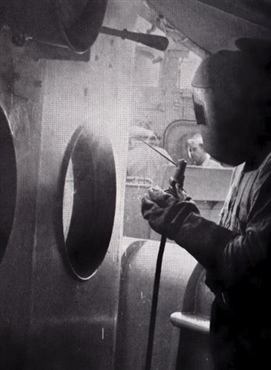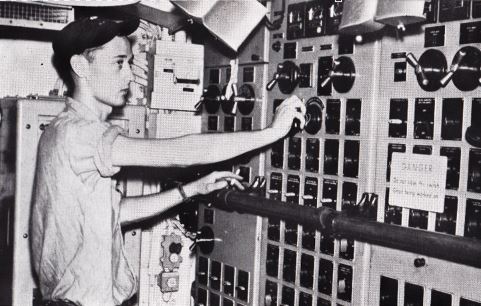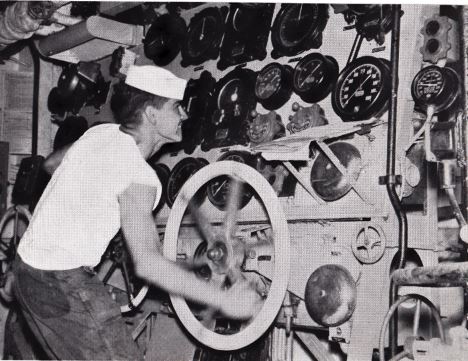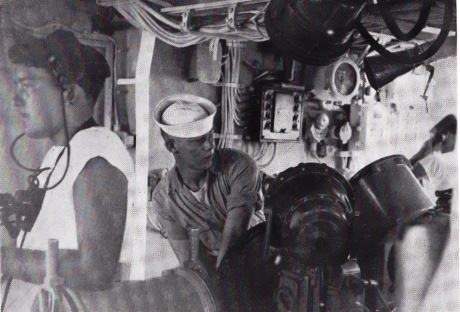Engineering Plant
60,000 HP with high-speed turbines driving twin screws!
by David R. Murphy, Chief Engineer 1959, 1960
The SHIELDS’ engineering plant had four boilers to make steam. That steam was used to turn her two propellers driving her through the water at speed up to 37 knots (almost 43 mph). Steam was also used to power pumps and other auxiliary machinery as well as to make electricity and to convert sea water into fresh water for cooking, drinking and showering. The engineering plant was housed in four big compartments and a few smaller ones.
Four Big Compartments
The four big compartments were the biggest on board. Each extended the entire way from port to starboard and from keel to main deck. Going aft on the main deck the first big compartment was the forward fire room; then the forward engine room, then the after fire room, then the after engine room. Each compartment had two hatches through the main deck, one on the port side, one on the starboard side. There were no doors in the bulkheads separating any of these big compartments from one another or from the rest of the ship. To go from compartment to compartment a sailor had to climb the ladder to a hatch and the travel on the main deck. Since the main deck was exposed to the weather, a sailor could sometimes get wet going from compartment to compartment or simply going on or off watch.
The forward fire room was almost completely filled with two boilers lined up fore and aft. The first boiler turned water into steam by burning fuel oil injected into it by one or more of its seven injectors. This steam at 650 pounds per square inch (psi) and 850ºF was sent to an engine room to drive SHIELDS through the water and to do many other things. The second boiler did the same thing. During normal cruising only one boiler was “on the line” i.e. making steam; at general quarters, both were.
Just aft of the forward fire room was the forward engine room housing a high pressure turbine and a low pressure turbine. While underway steam produced in a fire room was fed to the high pressure turbine making the turbine spin at high speed. This steam left the high pressure turbine at atmospheric pressure i.e. no pressure at all. But there was still energy to be recovered and that energy was recovered by turning the steam back into water. This was done in an enormous condenser the size of a pick-up truck. The condenser created a vacuum. This enabled SHIELDS to take steam from the high pressure turbine at atmospheric pressure, send it to the low pressure turbine and have the low pressure turbine wring out the last bit of energy by exhausting this steam to a vacuum.
Both the high and low pressure turbines spun too fast to directly turn the propellers. Their speed was reduced such that the propeller(s) turned at a much slower speed. This was done by a reduction gear connected to the starboard shaft.
Also in the forward engine room was an electrical generator powered by its own steam turbine and a large number of special purpose pumps. We had pumps to pump salt water through the condenser; to pump fresh water from the condenser back to the boiler(s); to pump lubricating oil into a centrifugal cleaner to keep it pristine; and pumps to keep salt water pressure on the fire mains to be used for fire-fighting. This salt water in the fire mains was also used to flush the toilets and urinals which flushed 24 hours per day seven days per week. We had an ocean full of salt water and it was important to keep the heads sanitary. It would have been wasteful to use fresh water for this purpose.
The forward engine room was also called “main control”, short for “main engine control” and was my general quarters battle station.
The after fire room was almost identical to the forward fire room with one minor exception; the starboard shaft from the forward engine room ran through it. The shaft was about a foot in diameter and was normally painted navy grey. One day I entered the after fire room and found that the crew had painted it with red and white stripes just like an old-time barber pole. I got dizzy watching it go around. It certainly did not conform to Navy Regulations, but “what the hell” I thought, “it still performs its intended function and if it makes the crew happy, why should I object”. I said nothing. I doubted that the captain or the exec would ever see it since they rarely entered the engineering compartments.
The after engine room was almost identical to the forward engine room except that it drove the port shaft. There were actually two engine order telegraphs, one connected to the after engine room for control of the port shaft, one in the forward engine room to control the starboard shaft. In the manner the conning officer on the bridge could tell us whether he wanted each engine to go forward or reverse and how fast. For example he ring up “ahead one-third” on the starboard shaft and “back on-third” on the port shaft causing SHIELDS to twist, a handy feature when approaching or leaving a pier.
Some Smaller Compartments
The after-most compartment on the ship was the steering gear room dedicated to the hydraulic equipment that moved the rudder.
SHIELDS had a fully equipped machine ship with a lathe, a drill press and lots of other shop equipment such that we could repair almost anything.
Just outside my stateroom in officers country was a compartment housing the emergency electrical generator. It was driven by a diesel engine and was set to start automatically if we “lost the load” navy-speak for a loss of electrical power. This emergency generator was not powerful enough to provide all SHIELDS needs but was sufficient to supply essential services.
The smallest engineering compartment was the size of a clothes closet and was located on the main deck amidships. Stored in that closet were: fire-fighting equipment; oxygen breathing apparatus (OBA) for use in smoky areas; timbers for shoring; material for patching holes in the hull; electrical cables; portable pumps for removing water from flooded compartments; and other damage control equipment.
Other Items of Equipment
The Engineering department was responsible for the repair and maintenance of other items including the two motor whale boats; the galley equipment including especially the ice-cream maker; three refrigerators called “reefers” each at a different temperature ideal for the food stuff stored there; an air compressor to supply 3000 psi air to the torpedoes and the movie projectors.
Fuel
With a full load of full fuel SHIELDS could steam about 5000 nautical miles at 15 knots called “standard speed” (a little over 17 mph) before her tanks were empty. She could make the 2600 mile, seven day trip from San Diego to Pearl Harbor using only half her fuel.
She could steam for 14 days at standard speed before running out of fuel. Empty tanks are, however a terrible state of affairs that we always tried to avoid. To maintain readiness we usually refueled about every three days at sea. This kept the tanks topped off meaning that if necessary we could operate for about a maximum of about ten days before being in danger of running out of fuel. SHIELDS refueled at sea by coming alongside a fleet oiler or an aircraft carrier. A fuel hose was passed to us and fuel oil was pumped to us until we topped off our tanks.
A responsible petty officer, usually a “BT2 or BT3” (boiler tender) was selected to have the job of “oil king” and that’s what we called him. He kept an eye on the amount of oil in each of the ships tanks and made a periodic report to me. We had no meters, no electronics; the oil king had a dip stick similar to that used in your automobile to see how much lubricating oil is in your car’s crank case. But since the SHIELDS’ tanks could be as tall as about twelve feet, the dip stick which we called a “sounding rod” was folded like a carpenter’s ruler. It was simple and worked well.
Water
While away from port we made our own fresh water by boiling sea water in a still and condensing the vapors. This fresh water was used for drinking, cooking, showering and replacing the fresh water lost due to inevitable leaks in the many steam driven devices on board. If we got really low on fresh water an announcement was made over the ships announcing system, called the “one MC”. If fresh water levels dropped further a threat was made to put the crew’s showers on “water hours”. In such a case water would be available in the showers only during certain hours of the day. During my three years on board (1957 to 1960) I believe we were never on water hours, a fact of which I am proud.
Not surprisingly the SHIELDS had a Water King who sounded the water tanks and made reports in much the same way as did the Oil King.
Electricity
While underway we made our own electricity, normally by running one or both of the two steam-turbine-driven electrical generators. In port we connected to shore power permitting us to shut down all our generators.
Operation of the Engineering Plant
The engineering plant was at its greatest state of flexibility and readiness when the ship was at general quarters. Normal steaming for example going from one port to another was more relaxed. In port we could shut all the boilers down and take water and electricity an sometimes steam from the shore.
At general quarters all four boilers were on the line producing steam and we were operating with a “split plant” by which I mean that the steam from the forward fire room went only to the forward engine room to drive the starboard propeller and the steam from the after fire room went only to the after engine room to drive the port propeller. With a split plant SHIELDS could continue to maneuver on one engine even if the other engine were disabled. Everyone in the Engineering department was at his battle station. The boiler men (BT’s) were in the boiler room. The machinist mates (MM’s) were in the engine rooms. The ship fitters (SF’s) the damage control men (DM’s) and the inter communication technicians (IC;s) were by the damage control locker ready to respond to extinguish fires, stop leaks, pump out flooded compartments, provide emergency power and maintain communications within the ship.
For normal steaming at 15 knots we only had two boilers on the line, one in the forward fire room and one in the after fire room. We still ran on a “split plant” because it was safer. We usually had enough men on board such that each crewman could be four hours on watch and eight hours off. If a crewman was “off watch” during the working day he still had other duties to perform.
In port we could shut down all four boilers and get electricity, water and sometimes steam from the shore. After the boilers cooled off, which took at least about six hours we could inspect them and make any necessary repairs. To get underway, the boilers had to be heated slowly to prevent warping which could cause damage. This took about three hours.
Summary
Like every other Fletcher class destroyer, the SHIELDS was well-designed and well-built. Her main propulsion plant could drive her through the water faster than any other capital ship. Only PT boats could go faster. She was equipped to torpedo or shoot at enemy ships or bombard enemy installations ashore. She could find and sink subs or shoot air craft out of the skies. She could pluck from the sea any hapless pilot who did not make it back to his carrier and we did this several time while I was on board. To do these jobs the engineering plant moved her through the water to the job site. The engineering plant supplied the electricity to move the ammo to the guns and to train her mounts and turrets, and to fill the torpedoes with high pressure air to burn the fuel as the torpedo sped underwater to the enemy. The engineering plant also kept our food from spoiling, and supplied the water we drank. All this was done by a group of dedicated men with whom I was privileged to serve.









